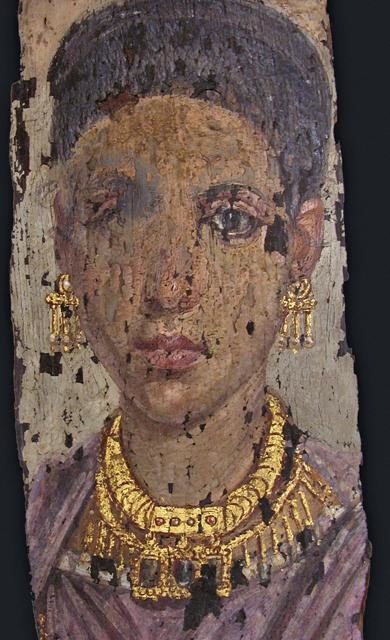In the popular imagination, the color spectrum of ancient Rome ranges only from alabaster to eggshell. We think of milky marble statuary and monotone colonnades, picturing citizens in white togas strolling through a sun-bleached forum. But as recent work in art and archeology has shown, this is a misperception born of accident and prejudice. In fact, most Roman statuary was painted in vivid hues, and Rome was a vibrant world full of colorful objects.
Over the millennia, color faded and wore off, and even when it was retained it rarely withstood preservationists’ cleaning attempts. Eventually, racist cultural biases reinforced a white, classical ideal that never actually existed.
Ancient Color, a special exhibition at the U-M Kelsey Museum of Archeology, offers a corrective. Co-curators Catherine Person and Carrie Roberts present a collection that depicts Roman history in its joyful, riotous glory, exploring how the empire’s residents created, deployed, and understood color.
Traders brought new materials to the Roman empire, and by its height, artisans had become adept at using them to create pigments and paints to adorn art, homes, and dress. Even their cemeteries were colorful. Houses were painted red, black, yellow, and blue. The museum’s stunning Villa of the Mysteries reproduction shows how vivid frescoes and tilework brightened Roman interiors.
In their dress, Romans used various shades to convey status and taste. A surviving bag, woven in red, teal, and ochre, looks like it could be part of Anthropologie’s spring collection. Like us, they wore team colors, wearing either blue or green to signal their support for Rome’s two dominant racing teams. The resulting crowds likely looked a lot like ours on U-M vs. MSU game days.
The exhibit also examines the ways color is cultural, reminding us that the associations we assign to colors (white with purity, black with death) are societally specific. Ancient Rome had entirely different associations. Blue signified mourning and bad luck. Yellow was a bridal hue. Purple denoted military success or royal status. As for pink and orange, the exhibit informs us, they did not even exist as categories of their own–there is no word for either in classical Latin–and they were probably thought of as shades of red.
The exhibit is child friendly and interactive. Video elements show the process researchers deployed to determine what pigments Romans used, and a coloring book of the exhibit’s pieces lets visitors, especially younger ones, experiment with different hues. The entire experience effectively colors visitors’ perceptions: afterward, examining the rest of the museum’s collection of items from ancient Greece, Egypt, the Near East, and Africa, we can’t help but imagine the vibrant worlds these came from as well.
Ancient Color continues through July 28.
Ancient Color at the Kelsey
The vibrant past

Credit: Courtesy Kelsey Museum